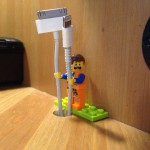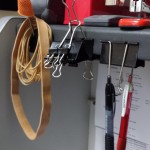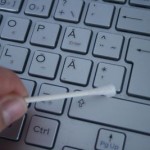5 Ergonomic Posture Tips
Ergonomics is key in the office world; without proper ergonomics, we simply can't reach our full potential at work. Incorrect posture at our desks will affect our health, comfort, and productivity. If our posture is correct and we feel comfortable, we will work smarter and be more alert on the job - not to mention promoting our health and wellness. To help achieve maximum coziness and and efficiency at work, we've put together a list of 5 ergonomic posture tips.
Monitor Height
If we spend long periods of time at our desks during the day, there's a good chance that we're looking at our computer monitors for a large part of the day as well. It's important to center our monitors so they are directly in front of us, and they should also be about an arm's length away when we are sitting back in our chairs. Our monitors should be screen level with our eyes, with our eyes looking at about the top third of the monitor. We should also be mindful of the brightness setting and should be aware of any glare coming in from an open window, as these can strain our eyes.
Office Chair
Ideally, we should be sitting in an office chair with lumbar support to help naturally cradle our backs and encourage correct posture. It is vital that we adjust the height of our chair so that our feet are resting comfortably on the floor. In our chairs, we should aim to center our bodies and to sit up straight, avoiding slouching back in our chairs (as tempting as this may be at times).
Object Positioning
One thing that can put an unnecessary amount of strain on our bodies is having to reach constantly for key items on our desk, such as our stapler or telephone. A good rule of thumb is to keep items that we use most frequently throughout the day within an arm's length. Our keyboards should be center with our bodies and computer monitor, and our computer mouse should be parallel on either the right or left side of the keyboard.
Wrist Positioning
Since we are typing so much throughout the day, it is also imperative that we keep our wrists in a comfortable position. One of the best ways to accomplish this and minimize further stress is through a wrist rest. When we are typing, we should hold our wrists in a straight and natural position above the wrist rest. After long periods of typing, we can then use the wrist rest to relax by keeping our palms on the wrist rest.
Accessories
There is a plethora of accessories designed for comfort and ergonomic health. One great accessory, particularly if we talk on the phone much during the day, is a Bluetooth headset. These wireless headsets are also wonderful for multitasking and being able to type on a keyboard while on the phone. Another ideal accessory for good ergonomics is a footrest. Footrests are perfect for when our office chairs are too high up for us, or when our feet are not naturally resting on the floor.
Do you have any ergonomic tips that help your work-wellness? We would love to hear them!
5 Workplace Hacks for the Office
Sometimes the smallest things can make our lives much easier. With simple items that might be lying around, we can transform a cluttered workspace into a place where we can flourish. Here are 5 workplace hacks that offer some extra organization and productivity to your space.
Hack #1: Lego Holders
Cords are messy, and with all of our chargers laying around it can make for a clutter zone on our desks. Legos are a perfect (and fun!) solution to hold those pesky cords and keep them from taking up precious space. Most desks have a circular cut-out area for cords to be more accessible. Try placing the Lego friends by these holes to have easy access to your chargers when it is time to use them. Your inner child will thank you for this hack.
Hack #2: Other uses for Binder Clips
Binder clips may be among the most common items you will find laying around the office, but there are more uses for the clips besides keeping your papers nice and neat. One of the best things you can do with binder clips is clip to them around your workspace to hold everyday work items like rubber bands and pens. Another great trick with binder clips is using them to fix your keyboard if the stand is broken! Also, if you need to make a quick stand to hold your cell phone, look no further than a trusty binder clip.
Hack #3: Bread Tag Labels
Chances are, at the bottom of our desks near our power strip we will find a tangled mess of cords. There is also a good chance that we are using almost every single socket on our power strip. It can be confusing to know which cable runs where, and what is safe to unplug. With simple bread tag labels, we will know know exactly what each cord is and never have to worry about unplugging our desktop computer when we meant to unplug our laptop charger!
Hack #4: Keyboard Cleaners
Unfortunately, our keyboards can get really dirty really fast, and we might not think to clean them or even know the proper way how. One of the easiest ways we can clean our keyboards is with some scotch tape. By sliding a strip between the rows on our keyboards, the adhesive side of the tape will automatically pick up things like computer dust and crumbs. Other useful items to clean keyboards include Post-It Notes and Q-Tips.
Hack #5: Cereal Box Dividers
Before you recycle that next box of cereal, you may find some uses for it at your office! By keeping your cereal boxes, you can turn them into a storage bin for your items or even dividers for your desk drawers. This is the perfect inexpensive solution for stashing all of your desk drawer items and keeping them organized. Here is a handy guide on how you can make the cereal box dividers.
Do you have any hacks that makes your life easier at work? We would love to hear about them!
10 Email Etiquette Tips for the Busy Professional
We've all been there - the times when our to-do list is seemingly endless, and our inbox just keeps filling up. It's easy to become overwhelmed by emails at times, but by following the 10 simple etiquette tips below, email management can be a breeze.
#1: Keep it Simple
First and foremost, we can ask ourselves if email is the best way to contact or reply to someone given the context. If we anticipate going back and forth quite a bit, or having to include a lot of details, it might be easier to visit with someone in person or pick up the phone. When email is our best option, we should aim to keep our emails as brief and to the point as possible. With so many emails now being read on smartphones and tablets, it is more tedious than ever to scroll through too much content.
#2: Professionalism
We should always be aware of whom we are emailing and always try our best to keep our emails professional in appearance. We should choose a font for our emails that is easy to read, not too big, and that would be standard across most operating systems. We should also aim to do a quick double-check on our spelling and grammar, making sure we use enough punctuation (and not too much - no need for 5 exclamation marks).
#3: Number Our Questions
We often need to ask questions via email. A good way to go about it is to number our questions and make sure they stand out. We can even use a bold font to show our reader that they are important and need an answer. If we don't number our questions, the reader may skim through the email and not realize that we needed multiple questions answered.
#4: Keeping Work & Personal Emails Separate
If we're using our work email all day, it can be tempting and easy to add our personal messages to the mix - but mixing work and personal emails is not ideal. First, the many personal emails we will inevitably receive distract us from the work we need to be doing in the first place. Second, most workplaces impose limits on the size of an employee's inbox, and personal emails take up valuable space needed to file and save important messages. Finally, many personal emails would simply not be viewed as professional in the workplace.
#5: Specify Deadlines
If we need to have someone accomplish something for us by a certain date, we should absolutely let them know in the email. By clearly communicating when we need something done, we enable the other person to be mindful of achieving a task in time. If something is important but doesn't necessarily have a due date, let the other person know as well, so they can prioritize their workload.
#6: Be Mindful of Attachments
When sending an email with attachments, it's always good to double-check that we are indeed attaching something and that it is the correct attachment! We should also be mindful that most work emails have size limitations, and those attachments can add up fast. No harm done to ask before sending over a large attachment.
#7: Sparingly Use the 'Reply All' Function
Many emails have multiple people involved, whether the message was sent directly to a group or if individuals were copied, or both. In most cases, it is absolutely fine to reply back to the original sender only. There are times when other recipients need to see your response - if it will affect their course of action, or if we are sharing something complimentary to the group - but we should think twice before replying to all, and do so only when necessary.
#8: Vacation Mode
When planning to be out of the office for extended periods of time, we should let others know. In our auto-reply emails, we should clearly define when we will be gone, when we will be returning, and a phone number to contact for urgent needs. If we don't want anyone to contact us directly, specify an alternate individual and their contact information for the sender of the email while we are away.
#9: Timely Responses
It is very important to be prompt with our responses to emails, for the sake of courtesy and professionalism. During the work week, we should aim to reply back to every email that needs a response within 24 hours; 48 hours should be the absolute maximum we wait to reply back to someone during the working week. If we know that meetings and obligations will delay our email responses, we can even say so in an auto-reply, and that we will respond as soon as possible. That will help the sender by acknowledging that we did in fact receive their email.
#10: Proper Signatures
We should make sure our email signatures look professional and and include sufficient contact information. Email signatures are also a great opportunity to share things like our social media pages, our company website, and any other information we want others to know (without overloading the signature with too much information). Finally, creating a complete email signature for our smartphones will help our messages have a professional feel even when we can't access our computers.
5 Keys to Spring-Cleaning your Office Space
Spring is officially here! With the changing of the seasons, we have probably started to take advantage of the nicer weather and longer hours of daylight. Spring is also the perfect time for workspace improvement, and what better way to accomplish it than by some good old-fashioned spring cleaning. Here are 5 tips to get your office space feeling right again.
#1: Organize!
When most people think of spring cleaning, what often comes to mind is throwing things away. While this is certainly helpful, sometimes we simply need is to organize all the belongings around us. We should divide all of items on our desk into zones if we can, and tools like filing cabinets can provide much-needed space. A good rule of thumb is to keep everything you need within an arm’s length, and everything else neatly put away.
#2: To-do, To-Read, To-File
Continuing the first organization tip, every paper we have should be organized into three categories: to-do, to-read, and to-file. Start by organizing all papers into these three piles; from here, we can have three labeled binders for easy placement of everything going forward. By using these three categories, we can eliminate that mountains of paper that inevitably end up on our desks at times.
#3: Clean Up that Clutter Drawer
The good, old clutter drawer. Chances are we've all had one at some point in time - that infamous top drawer where we keep all items we need in some way, but don’t necessarily like to have on our desks. By throwing everything into one drawer, it will be difficult to find our stapler or sticky notes when we will actually need to use these items. Drawer dividers or organizers are a great way to place all of our items into organized sections so we can easily access the items we need.
#4: Digital Clutter
So now you have your desk and office space cleaned off - nice work! Unfortunately, there is probably a bigger mess lurking in the computer. It's to stash all of the files we need on our desktop, or in one master folder - but that won’t do any favors to our stress levels. The same can be said for not properly organizing and deleting or archiving emails. Luckily, our computers and software have great built-in filing and organization systems. We should create an adequate number of folders that are easy to access, and regularly delete old files on our computers to keep the digital clutter at bay.
#5: Regular Upkeep
Let’s not wait until spring every year to clean our office space! One of the best things we can do is establish a limit for how much clutter we can comfortably deal with. We all get busy, and things eventually pile up, but when we hit our clutter capacity it's time to clean things up. By spending minimal amounts of time doing some basic cleaning each week, we can all breathe a sigh of relief and maintain our ideal work environment.
Do you have any spring-cleaning suggestions or techniques to maintain a clutter-free office? Share them with us!
Celebrating St. Patrick's Day at the Office
Happy St. Patrick's Day from EON!
Here are some of our suggestions for bringing out your inner leprechaun and spreading some St. Patrick's Day cheer around the workplace.
Lots o' green!
It's no secret that the traditional way to celebrate St. Patrick's Day at the office is to wear green (if you don't, you might risk getting pinched!) Try wearing a green tie, green suspenders and green pins you can attach. Now is also a great time to finally bring that green purse out of the closet. Also make sure to integrate green in to the office decor! Green shamrock cutouts are always a nice touch as well as things like mini leprechaun hats that can be placed on your employee's desks.
Irish Food
That peanut butter and jelly sandwich can wait a day, St. Patrick's day is a great day to try some unique food. Try bringing in some traditional Irish food such as corned beef, bangers and mash, and Irish soda bread. Potatoes are always classic, and you can always make shamrock cookies to be shared around the office! Here is also a great recipe from the food network for green punch. Dress like a small leprechaun, but be sure to bring a big appetite this year.
Irish Music
If you won't be able to attend a St. Patrick's Day parade this year, you can always bring a little bit of entertainment right to your office life. Play some folk music on your break and try your hand at Irish Step Dancing. The Dubliners, The Chieftains, and Planxty are great Irish artists you can start with. You can also play some more recognizable artists such as U2 and Van Morrison who have Irish heritage.
May the luck of the Irish be with you!
How to Enjoy (& Not Envy) Our Coworkers' Success
With St. Patrick's Day recently behind us, we all probably saw a lot of green being worn around the office. One kind of green we don't want to see around the workplace is envy, which is insidious and harmful to everyone around us. Sometimes it's hard to appreciate the success of our coworkers and not feel a little bit of jealousy. But envy is detrimental to our work life; it can harm our relationships, team performance, and most importantly, ourselves. Here are a few strategies we can use to put envy behind us and truly enjoy the accomplishments of our co-workers.
Don't Fall into the Comparison Trap!
A lot of people in the workforce are competitive, but constantly stacking ourselves up against coworkers isn't good for our mental health. A little friendly competition is fine, but it becomes a problem when we start to lose gratitude and develop negative feelings towards others. One problem with comparing ourselves to others is that we often only compare ourselves to people whom we perceive to be "above" us. This can only set us up to feel unhappy or that we are not as good as someone else. The only comparison we should be making is that of our present self versus our past self - that way we can see more of our own value and how much we have grown over time.
Affirm Yourself!
If someone gets a promotion or closes that big deal, our natural reaction might be, "It should have been me!" Instead of coming up with reasons why someone shouldn't have had something positive happen to them, we should look for key takeaways that could benefit our own performance. Maybe we could come in earlier, ask more questions, volunteer for more responsibilities, etc. We are capable of whatever we set our minds to! Try to replace those feelings of discouragement with positive affirmations to yourself, and believe you can achieve whatever it is that you want.
The Team Philosophy
At the end of the day, we need to remember that everyone is a part of one collective unit. Much like a sports team, we should all be working to help our organization move forward, and celebrate when something positive happens to one of our teammates. Great players can only carry a team so far - we all need to look for opportunities to help the team in whatever way we can. To truly help everyone, and most importantly ourselves, we need to replace jealousy with feelings of appreciation and gratitude, so we can all enjoy the celebration.









